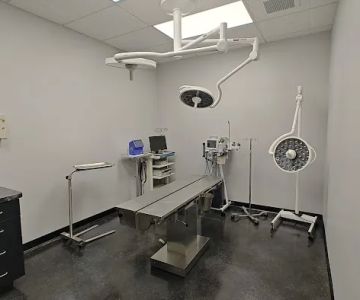How Much Do Veterinary Practices Sell For?
When it comes to buying or selling a veterinary practice, one of the most important questions that arises is: "How much is it worth?" Whether you’re a veterinarian looking to sell your practice or an entrepreneur hoping to acquire one, understanding the valuation of a veterinary practice is crucial. This article dives into the factors that affect the sale price of veterinary practices and provides insight into how to determine their market value. We'll explore everything from financial considerations to market trends, offering a comprehensive look at this important topic.

12058 Vance Jackson Rd STE 101, San Antonio, TX 78230, USA
See Details1. Understanding the Valuation of Veterinary Practices
Veterinary practices are a unique asset in the healthcare industry. Unlike many businesses that can be valued purely based on their revenue and assets, veterinary practices require a more nuanced approach to valuation. The value of a veterinary practice is determined by several factors, including its financial health, the location of the practice, the client base, and its overall reputation. These factors combined create a snapshot of the practice's worth, but the final sale price is also influenced by current market conditions, demand, and negotiations between the buyer and seller.

AZ, 12020 S Warner Elliot Loop # 101, Phoenix, AZ 85044, USA
See Details1.1 Financial Factors that Influence Sale Price
The most significant factor affecting the sale price of a veterinary practice is its financial performance. This includes revenue, profitability, and how efficiently the practice is managed. Potential buyers will look at the practice's financial statements over the past several years to gauge its financial health. Practices that are financially stable, with consistent revenue growth and solid profit margins, will generally command a higher price. If the practice has debts or ongoing financial challenges, the value may decrease.
1.2 Location and Demographics
Location plays a major role in determining the price of a veterinary practice. Urban practices in densely populated areas often sell for more than rural practices due to a larger client base and increased demand for veterinary services. Additionally, the demographics of the location matter. For instance, areas with higher numbers of pet owners or those that are seeing an increase in population growth may drive up the value of a veterinary practice. Buyers often look for locations that are easily accessible and have the potential for growth.
2. Key Metrics Used to Value Veterinary Practices
There are several key metrics that buyers and sellers rely on when valuing a veterinary practice. Understanding these metrics can help sellers set a realistic asking price and allow buyers to assess whether a practice is worth the investment.
2.1 Earnings Before Interest, Taxes, Depreciation, and Amortization (EBITDA)
EBITDA is a key financial metric used to evaluate the profitability of a veterinary practice. It gives buyers a clearer picture of the practice's operating performance by excluding non-operating expenses such as taxes, interest, and depreciation. A higher EBITDA typically translates into a higher sale price, as it shows the practice’s ability to generate profits without external influences. Veterinary practices with higher EBITDA ratios are generally more attractive to potential buyers.
2.2 Multiple of Revenue
Another common method used to value veterinary practices is by applying a multiple of revenue. This method involves multiplying the practice's annual revenue by a factor (or multiple) that reflects the industry standard. The multiple can vary depending on the practice's size, location, and overall financial health. In the veterinary industry, the typical multiple ranges from 0.5 to 1.5 times annual revenue, although practices in highly desirable locations or with specialized services may attract higher multiples.
2.3 Client Base and Retention Rates
The client base and retention rates of a veterinary practice are also critical in determining its value. A strong, loyal client base signifies long-term stability and the potential for continued revenue generation. Veterinary practices with a high client retention rate are seen as more valuable, as they have an established customer base that is likely to return for future services. Additionally, the quality of client relationships, the frequency of visits, and the diversity of services provided all impact the sale price.
3. The Role of the Seller and Buyer in the Sale Process
Both the seller and buyer play significant roles in determining the final sale price of a veterinary practice. Sellers typically have a target price in mind, but it’s essential for them to work closely with a broker or financial advisor to set a realistic price based on market conditions and the practice's performance. Buyers, on the other hand, will conduct due diligence to assess whether the practice's asking price is justified based on the metrics discussed earlier. Effective communication and negotiation skills from both parties can result in a mutually beneficial agreement.
3.1 Seller's Perspective: Setting the Right Price
From the seller’s perspective, the key to maximizing the sale price is preparing the practice for sale by ensuring that its financials are in order, addressing any operational inefficiencies, and showcasing its strengths. Sellers should also be transparent about any liabilities or challenges the practice faces, as this will help establish trust with potential buyers. Setting a realistic price is critical—overpricing a practice can scare away buyers, while underpricing can result in a loss of value.
3.2 Buyer’s Perspective: Evaluating the Worth
As a buyer, it's essential to evaluate the worth of a veterinary practice carefully. Conducting thorough due diligence—such as reviewing the financial records, assessing the condition of the facility, and understanding the demographics of the client base—will help determine if the asking price is justified. Buyers may also seek advice from industry experts or veterinary business brokers to help assess the practice’s value and avoid overpaying.
4. The Impact of Market Trends on the Sale Price
Just like any other business, the market conditions at the time of the sale play a role in the price of a veterinary practice. The veterinary industry has seen fluctuations in demand and pricing over the years, and these trends can affect the sale price. In periods of economic growth, demand for veterinary services typically rises, leading to higher sale prices. Conversely, during times of economic downturn, the sale price may be lower due to reduced consumer spending on pet care services.
5. Conclusion: What You Need to Know About Selling a Veterinary Practice
In conclusion, the price of a veterinary practice depends on a range of factors, including financial performance, location, client base, and market conditions. Understanding these factors and how they influence the final sale price can help sellers set a realistic price and help buyers assess the value of a practice. Whether you’re a seller or a buyer, having a clear understanding of these valuation methods and trends will help you navigate the process and make an informed decision.
SEO Title: How Much Do Veterinary Practices Sell For SEO Keywords: veterinary practice valuation, veterinary practice sale, how much is a veterinary practice worth, selling a veterinary practice, buying a veterinary practice SEO Description: Discover the factors that determine how much veterinary practices sell for. Learn how financials, location, and client base impact the sale price.








